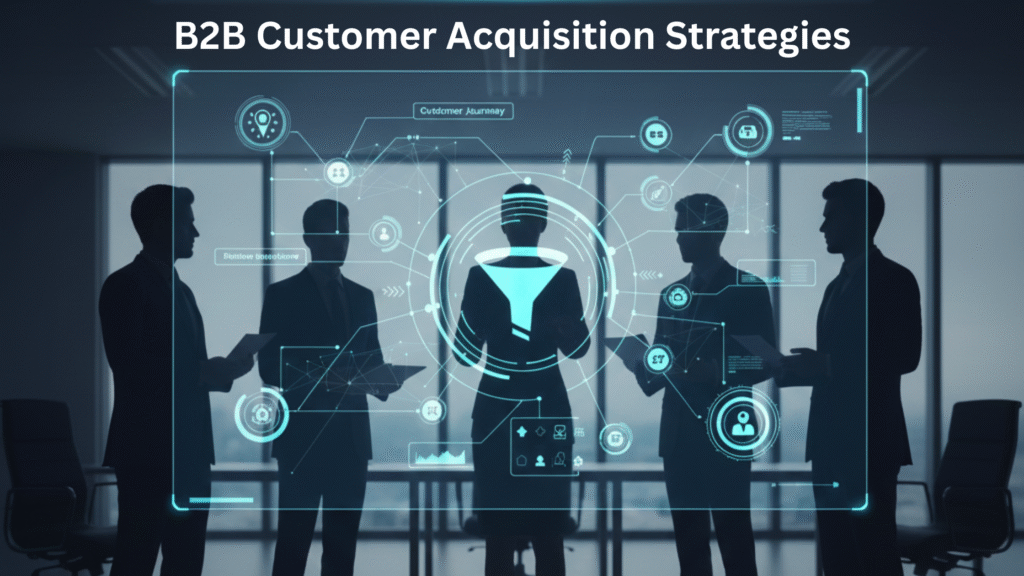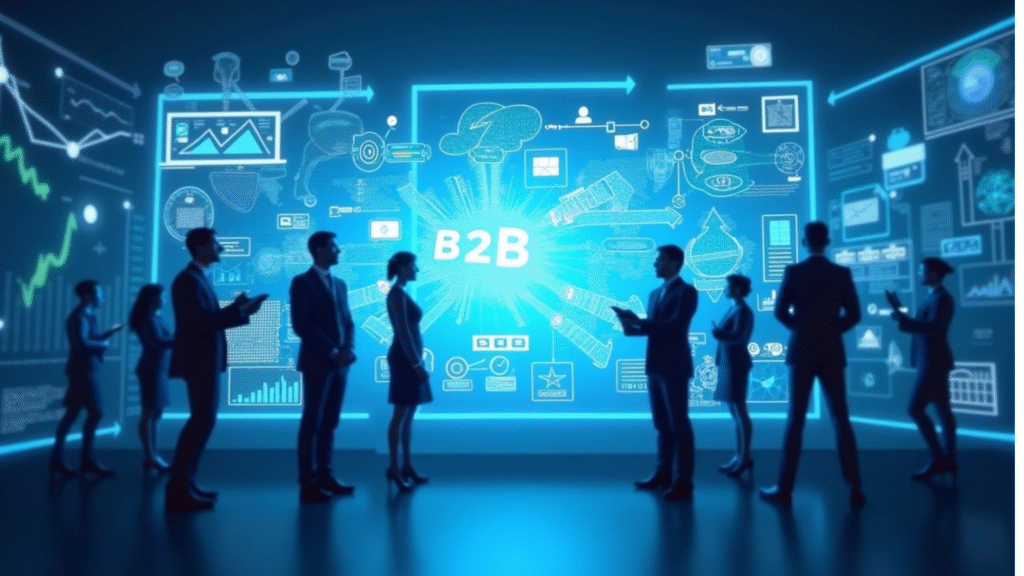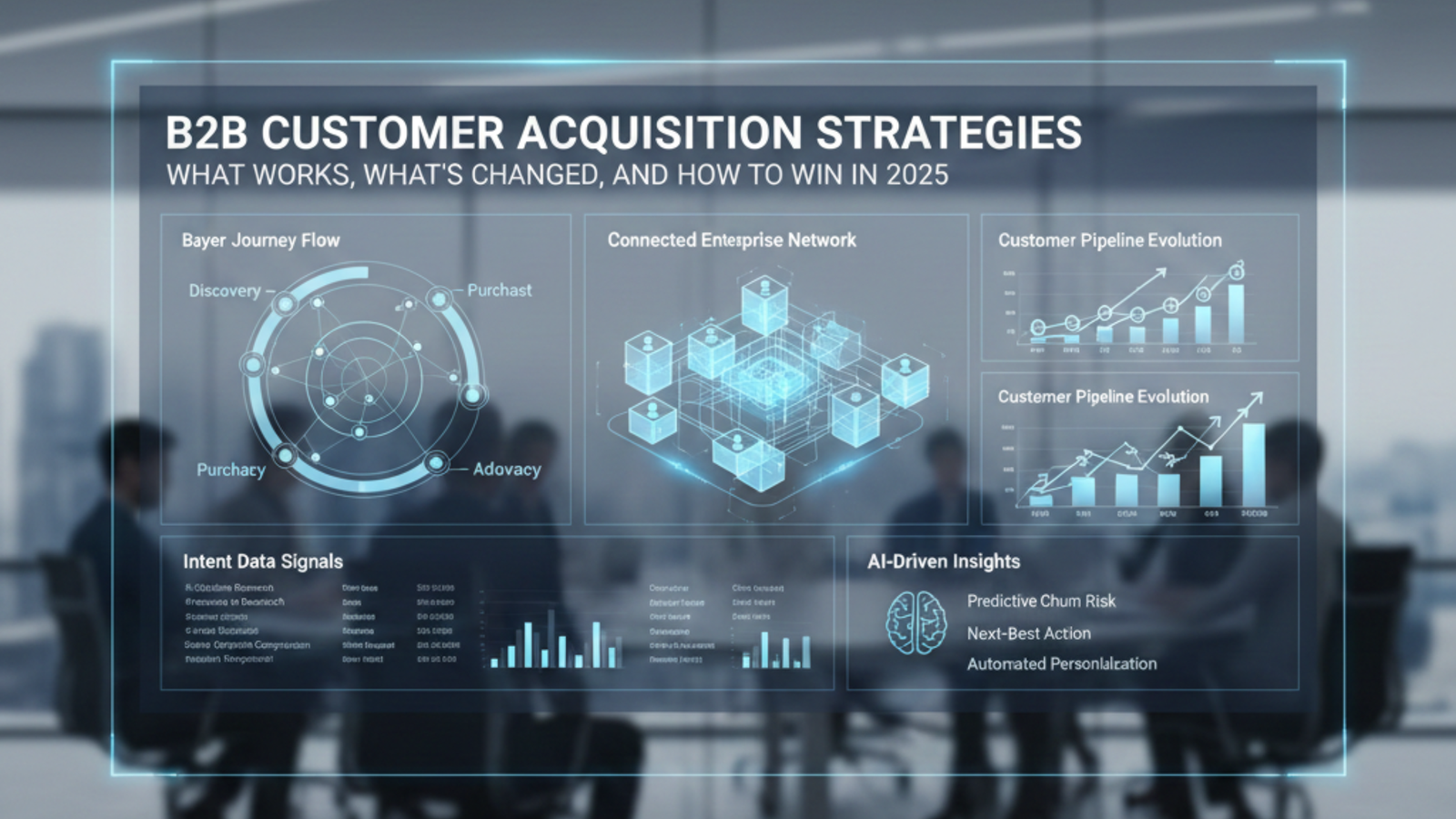B2B Customer Acquisition Strategies: What Works, What's Changed, and How to Win in 2025
The numbers tell a sobering story: 61% of B2B marketers say generating high-quality leads is their biggest challenge, yet companies continue pouring resources into strategies that worked five years ago but fail today. If your sales team is drowning in unqualified leads while your best prospects slip through the cracks, you’re not alone—you’re experiencing the seismic shift in how B2B customer acquisition actually works in 2025.
The traditional playbook is broken. Cold calling yields a 2% success rate. Generic email blasts get deleted. Trade show leads go cold before your team can follow up. Meanwhile, your buyers have evolved: they research independently, involve 6-10 stakeholders in purchase decisions, and expect personalized engagement at every touchpoint.
This guide reveals the B2B customer acquisition strategies that top-performing companies are using right now—not theoretical frameworks, but proven tactics generating measurable pipeline growth. You’ll discover why conventional approaches are failing, which innovative methods are winning, and how to build a customer acquisition strategy that delivers qualified prospects ready to buy. Whether you’re a CEO evaluating your go-to-market approach or a VP of Sales rebuilding your pipeline, these insights will help you acquire customers more efficiently and predictably.
The Hard Truth: Why Your Current B2B Customer Acquisition Strategy Is Failing
Your prospects have changed fundamentally, but your acquisition approach hasn’t kept pace. The average B2B buying journey now spans 192 days—and 70% of that journey happens before a prospect ever contacts your sales team. By the time they reach out, they’ve already formed opinions, evaluated alternatives, and narrowed their choices.
Traditional methods are collapsing under new buyer behavior:
- Cold outreach faces unprecedented resistance. Gatekeeper AI screens calls, spam filters block emails, and LinkedIn connection requests get ignored at record rates
- Content marketing without distribution strategy produces traffic that doesn’t convert. Publishing blog posts and hoping for organic discovery no longer generates sufficient pipeline
- Trade shows and in-person events deliver diminishing returns as digital-first buyers prefer remote research and vendor evaluation
The core problem? Most b2b customer acquisition strategy approaches treat prospects as passive recipients of your messaging rather than active researchers controlling their own buying process. You’re interrupting when you should be attracting. You’re pitching when you should be educating.
Data from Gartner reveals that B2B buyers spend only 17% of their purchase journey meeting with potential suppliers—and when considering multiple vendors, that drops to just 5-6% per supplier. Your window for influence is shrinking while competition for attention intensifies.
The buying committee has expanded, creating new acquisition challenges. IT evaluates technical requirements, procurement negotiates pricing, legal reviews contracts, finance analyzes ROI, and end-users assess usability. Each stakeholder researches independently, has different priorities, and can veto the purchase. Sales strategies for b2b must now engage entire buying groups, not just primary contacts.
Your competitors who’ve adapted are winning deals faster and at higher close rates. They’ve shifted from interruptive outbound tactics to strategic inbound positioning combined with precise, intent-based outreach. The question isn’t whether to change—it’s whether you’ll change before losing more winnable deals.

What’s Actually Working: Modern B2B Customer Acquisition Strategies That Drive Pipeline
The highest-performing B2B companies have cracked the code by combining three elements: intent-driven targeting, multi-stakeholder engagement, and value-first interactions. Here’s how they’re building predictable acquisition engines.
Intent-Based Account Identification
Stop chasing everyone. Start pursuing companies actively researching solutions like yours. Modern customer acquisition strategy examples begin with intent data platforms like Bombora, 6sense, or ZoomInfo that track which accounts are consuming content about your category, competitors, or related problems.
A cybersecurity firm increased qualified pipeline by 340% by targeting only accounts showing intent signals across three or more relevant topics within 30 days. Their SDRs contacted prospects already deep in research, dramatically improving conversation quality and conversion rates.
Reverse-Engineering the Buyer Journey
Map your ideal customer’s actual research path, then position yourself at every decision point. Interview recent customers to learn: What triggered their search? Which content influenced them? What concerns nearly derailed the purchase?
One SaaS company discovered buyers always searched for “ROI calculator for [their solution category]” before evaluating vendors. They built an interactive calculator that collected contact information and buying stage data while providing immediate value. This single asset generated 43% of their qualified pipeline.
Multi-Threading at Scale
Engaging multiple stakeholders simultaneously accelerates deals and reduces no-decision outcomes. Use personalized campaigns that deliver role-specific value:
- For CFOs: ROI models, total cost of ownership analyses, and financial case studies
- For IT Leaders: Technical architectures, security documentation, and integration guides
- For End Users: Tutorial videos, comparison charts, and peer reviews
- For Procurement: Pricing transparency, contract flexibility, and vendor evaluation checklists
Technology platforms like Demandbase and Terminus enable automated multi-stakeholder campaigns that feel personalized while remaining scalable.
Strategic Content Partnerships
Distribution matters more than creation. Partner with industry publications, analyst firms, and complementary vendors to reach your ICP through trusted channels. Co-created research reports, joint webinars, and contributed articles position you as a thought leader while borrowing credibility from established brands.
A marketing automation vendor partnered with a CRM platform to publish joint research on sales and marketing alignment. The report reached 15,000 decision-makers at target accounts—qualified leads they couldn’t have accessed independently.
Community-Led Acquisition
Build communities where prospects gather to solve problems, share insights, and connect with peers. Slack groups, LinkedIn communities, and member forums create ongoing touchpoints that nurture relationships long before sales conversations begin.
One infrastructure software company grew their Slack community to 8,000 members, generating 120+ qualified opportunities quarterly from community engagement alone. Members who joined the community converted at 3x the rate of other channels.
These strategies for customer acquisition share a common thread: they provide genuine value before asking for anything in return. They meet buyers where they are, with what they need, when they need it.

Building Your Tech Stack: Tools That Amplify B2B Customer Acquisition
Technology alone won’t fix a broken strategy, but the right tools make effective b2b customer acquisition strategy approaches scalable and measurable. Here’s the essential stack for modern acquisition:
Intent and Account Intelligence Platforms
These tools identify which companies are actively researching solutions and track buying signals across the web. ZoomInfo Intent, 6sense, and Bombora monitor content consumption patterns, revealing accounts entering the market before they contact any vendors.
ROI reality check: Companies report 20-30% higher win rates when targeting intent-qualified accounts versus generic outbound. Implementation costs range from $2,000-$10,000 monthly depending on database size and feature requirements.
Orchestration and Personalization Engines
Platforms like Demandbase, Terminus, and RollWorks orchestrate multi-channel campaigns across display advertising, LinkedIn, email, and web personalization. They enable account-based experiences that adapt based on engagement and buying stage.
A manufacturing software company used Terminus to serve customized web experiences to target accounts. When prospects from priority companies visited their site, they saw industry-specific case studies, relevant product features, and personalized calls-to-action. Web-to-opportunity conversion increased 156%.
Conversational Intelligence and Revenue Orchestration
Gong, Chorus, and Clari analyze sales conversations to identify what messaging resonates, which objections arise most frequently, and how top performers navigate deals. These insights refine your acquisition messaging and improve conversion throughout the funnel.
Integration with your CRM creates closed-loop reporting: track which acquisition sources produce deals that close fastest, at the highest values, with the best retention rates. This data-driven approach eliminates guesswork and optimizes budget allocation.
Strategic Questions for Tool Evaluation:
- Does this integrate seamlessly with our existing CRM and marketing automation platform?
- Can we measure incremental pipeline and revenue contribution, not just engagement metrics?
- Will our team actually use this, or will it create more complexity than value?
- Does the vendor provide strategic guidance, or just software access?
The LinkedIn Sales Navigator Reality
While often overlooked as “just LinkedIn,” Sales Navigator remains one of the highest-ROI tools for B2B acquisition. Advanced search filters identify decision-makers at target accounts, real-time alerts notify you of job changes and company milestones, and InMail provides direct access to hard-to-reach executives.
A financial services firm generated $4.2M in closed revenue from Sales Navigator leads in one year—a 12x return on their $15,000 annual investment. The key? Their SDRs used boolean search to identify CFOs at companies recently announcing expansion, then led with relevant insights rather than product pitches.
Email Intelligence and Deliverability Tools
Apollo, Instantly, and Smartlead ensure your outbound emails reach inboxes rather than spam folders while providing performance analytics that improve messaging over time. They’re essential infrastructure for scaled outreach programs.
The right technology stack makes your customer acquisition strategy examples repeatable and predictable. But remember: tools amplify strategy—they don’t replace it. Start with clear acquisition objectives, then select technology that enables execution at scale.

Your 90-Day Implementation Roadmap: From Strategy to Results
Theory without execution changes nothing. Here’s your practical path to implementing modern B2B customer acquisition strategies that generate qualified pipeline within 90 days.
Days 1-30: Foundation and Targeting
Refine your Ideal Customer Profile using closed-won analysis. Identify firmographics (company size, industry, location), technographics (current technology stack), and behavioral signals (intent topics, engagement patterns) that predict successful customers.
Deploy intent monitoring for your top 200 target accounts. Set up alerts when accounts show buying signals so your team can engage at the optimal moment.
Audit existing content through your buyer’s lens. Which assets answer critical questions at each buying stage? Where are the gaps? Prioritize creating high-value content for decision points your research revealed.
Days 31-60: Campaign Launch and Optimization
Launch your first account-based campaign targeting 50 high-intent accounts. Coordinate personalized outreach across email, LinkedIn, targeted ads, and direct mail. Each touchpoint should reference relevant insights or provide role-specific value.
Implement multi-threading by building stakeholder maps for target accounts. Identify 3-5 key decision-makers per account and develop personalized sequences for each role.
Track early metrics: engagement rates, meeting booking rates, and pipeline velocity. Run weekly optimization sessions to refine messaging based on what’s working.
Days 61-90: Scale and Measurement
Expand successful campaigns to additional account segments. Double down on channels and messages producing the highest conversion rates.
Establish closed-loop reporting connecting acquisition sources to revenue outcomes. Calculate customer acquisition cost (CAC) by channel and compare lifetime value to ensure positive unit economics.
Build your content distribution engine. Establish partnerships, guest contribution opportunities, and syndication relationships that extend your reach beyond owned channels.
Critical Success Factors:
- Alignment between marketing and sales: Weekly pipeline reviews ensure both teams agree on target accounts, messaging, and handoff criteria
- Patience with emerging channels: Community building and thought leadership take time but compound over time
- Willingness to kill underperforming tactics: If something isn’t working after 60 days, reallocate resources to proven approaches
The companies winning with sales strategies for b2b aren’t necessarily spending more—they’re spending smarter, targeting better, and measuring ruthlessly. Your competitive advantage comes from execution excellence and continuous optimization.
The B2B buying landscape has fundamentally changed, and customer acquisition strategies must evolve accordingly. Generic outreach, interruptive tactics, and hope-based marketing no longer generate predictable pipeline. The path forward requires intent-driven targeting, multi-stakeholder engagement, strategic use of technology, and relentless focus on providing value before asking for commitment.
Start by implementing intent monitoring for your top target accounts this week. Identify which companies are actively researching solutions like yours, then engage them with relevant insights and role-specific value. This single shift—from interrupting strangers to engaging active researchers—will transform your acquisition results.
Ready to build a predictable B2B customer acquisition engine? Our team specializes in helping US companies implement these strategies with customized approaches for your market, solution, and buyer. Schedule a pipeline assessment to discover which tactics will generate the fastest results for your specific situation.

